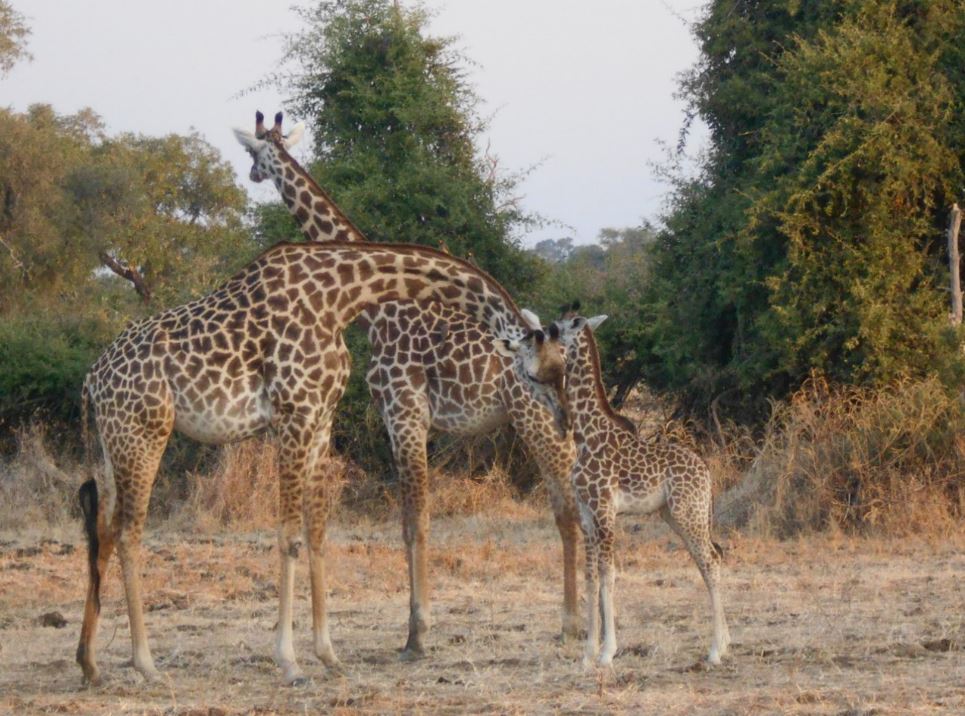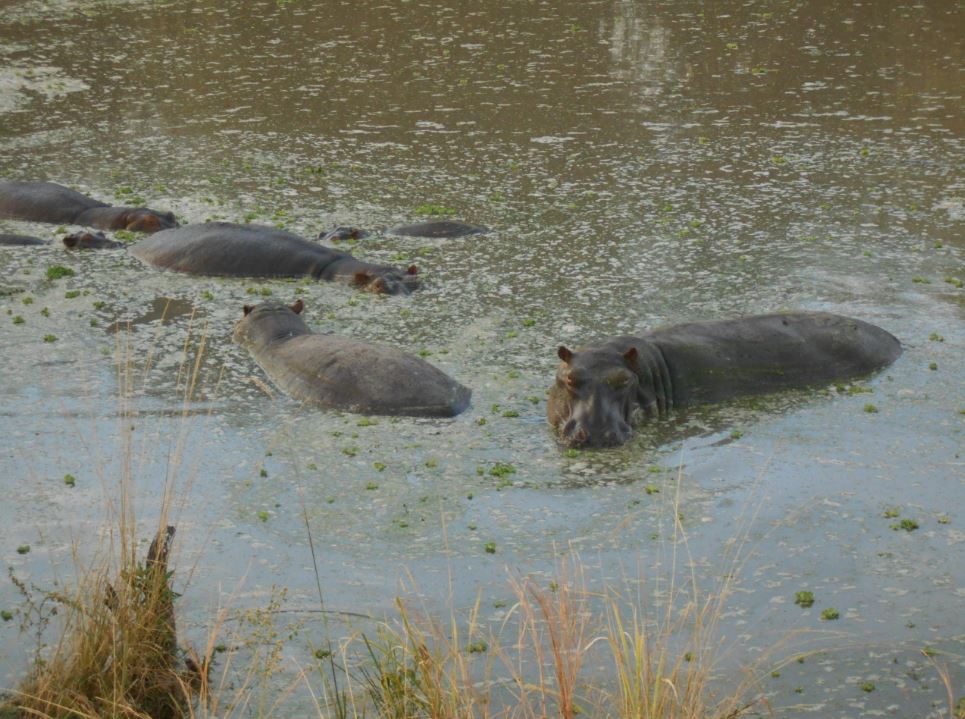South Luangwa National Park Game Drives – Part One
Claire and I had been in Zambia for just one night before we jumped on a bus that took us right to the door of Marula Lodge on the edge of South Luangwa National Park. When we arrived we were taken aback. Not only were we handed a lovely glass of iced tea on arrival, but we were also amazed to see that the lodge was built right on the edge of the Luangwa River and down below us, mere metres away, were a bunch of hippos and crocodiles. And just across the river stood a handful of elephants. We weren’t even on the game drive and we were still able to see these great animals in all their glory. Not only do you get a fantastic view of the animals bathing in the river, but in the evening and during the night, the hippos and elephants make their way up into the grounds of the lodge to graze on the grass and trees. Obviously you have to be careful, especially in the dark, when wandering around. You don’t want to bump into a hippo on land, they are incredibly dangerous. Speaking of hippos, they make really loud grunting noises which sound like a mix between a gigantic pig snorting and a deep booming laugh. You can hear them all through the night and at times there will be five or six all grunting at once. It sounds like one of them has told a joke and the rest are all in fits of hysterics.
We arrived at the lodge late, ate dinner and jumped into the safari tent that would be our home for the next few days. In the morning Claire and I woke up at 5am to eat breakfast at 5.30, and by 6am we were off on our first game drive with David our fantastic guide. We were accompanied on the first drive by Cristina and Kate, a pair of paramedics from Australia, though Kate now lives in London; and Christine, an English lady from Northampton who now lives in Brunei. David was behind the wheel, he was a big man with a huge wealth of knowledge and had an answer to every question anyone put to him. It was thanks to him that our first day in South Luangwa National Park was so much fun.
The park has a real mixture of terrain, shrubbery, trees and, of course, a fantastic range of animals. The morning drive saw us head out at 6am and after three hours we stopped by the edge of a swamp for some tea and cake, before slowly making our way back for 10am. Before the tea break we were able to see plenty of hippos in the river and occasional swamp. We also managed to spot some giraffes, zebras, a few elephants and some crocodiles. And, on top of these we were able to watch a number of different species of antelope as well as amazing birds. We saw the African fish eagle – which is the national bird of Malawi, another eagle that I cannot remember the name of and an impressive falcon perched high up in a tree. As well as these we also saw many others including the saddle billed stork, which is a beautiful bird with some bright and vibrant markings.

Every time we came across an animal David was able to offer insights into their behaviour or how to identify the gender of the animal you’re looking at. For example male zebras have a thin black stripe between their buttocks, and the females have a much larger, more prominent stripe. Hearing David saying the word ‘buttocks’ in his deep voice and Zambian accent was great. Zebras are also good at confusing lions when they are being hunted. When lions attempt to hunt zebras they will gather together to allow their markings to create an optical illusion to make it hard for the lions to identify individuals. Pretty impressive isn’t it? I think zebras are my favourite animal. Along the drive we were hoping to come across some of the great predators that South Luangwa National Park has to offer. We were, however, unable to spot any lions, leopards, wild dogs or hyenas.
We stopped for a tea break by the edge of the swamp and all disembarked the truck. David opened up a box of muffins and we all enjoyed a cup of tea whilst talking to him about the animals we’d seen. It was during the break that we noticed that the swamp we were stood next to was home to a number of crocodiles. We made sure not to go too near to the edge, but did spend the next fifteen minutes glancing over our shoulder keeping an eye out for crocs. When looking for crocodiles we spotted an animal that we were not expecting to see at all. Perched on a rock, with his head held high, was a terrapin.
On the drive back we were still hoping to spot a big predator, but unfortunately we were unlucky. The national park was beautiful, and there were plenty of amazing animals on display. So what if we didn’t see a lion, we still had three more game drives to go during our stay.
When we got back to the lodge we had lunch and then Claire and I sat by the edge of the river watching the animals down below. There was a crocodile sitting on the river bank and a pair of geese were wandering towards it. The crocodile spotted them and made its way into the water to set up an ambush. We all got to the edge of our seats excited at watching a crocodile hunting. The geese got nearer. Our anticipation grew. Then, just as the birds were within snapping distance of the croc, a second crocodile, much smaller than the one we were watching, made a lunge and missed. The geese flew off and the original croc gave up its attempts at securing a meal.

After an afternoon spent relaxing by the river we were off on our second game drive. The afternoon drive left the lodge at 3.30pm, stopping for a break to watch the sun set, before switching on the spotlight and driving through the night for the last hour and a half trying to spot the predators that tend to come out under cover of darkness. During the drive we saw yet more crocodiles, hippos, elephants and giraffes as well as plenty of other herbivores hanging around the plains. We then made our stop for sundowners and enjoyed a beer standing around watching as the sun set behind some trees. The scene was beautiful. The sky turned a vibrant neon pink, that our camera simply couldn’t capture. After the sun set and we’d finished our beers we all jumped back into the truck and continued on our way. That afternoon we’d been joined by a Dutch family and David’s assistant who was holding the spotlight. We were slowly making our way around in the pitch black, all of us following the spotlight with our eyes hoping to see the reflection of cats’ eyes shining back at us.
Around half an hour after sunset David’s phone went off. He pulled up, spoke for one minute and then hung up the phone. He then said to us that he was going to drive fast and we all held on tight. We sped through the park, slowing down only when the terrain required it, and within minutes we had come across a leopard. Sitting out in the open, the big cat was being watched by some tourists in another car. We pulled up alongside and sat watching this majestic creature for ten minutes. Leopards are beautiful. We were yet to see one in daylight on this trip, but even when illuminated by a spotlight in the dark, their coats still look impressive. The cat was unperturbed by our presence and the car next to us was using a red light to highlight the animal. We asked David why they were using a red searchlight and he told us that it is because it allows us to see the animal, whilst also ensuring that none of the antelope in the area can see it. Apparently the red light is only visible by human eyes, which means you aren’t giving the predator’s location away to its prey.
We made our way back for the evening meal all pretty happy about the fact that we’d seen the leopard out in the open. The next day we were heading out for two more drives, and now that we’d seen this big cat our optimism had turned up a notch. ‘Maybe tomorrow’ we thought, ‘we’ll see lions’.








Comments are closed here.